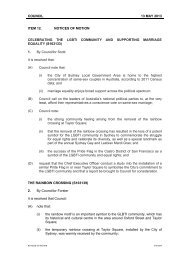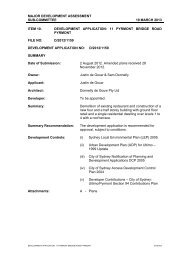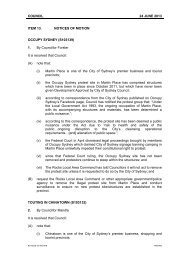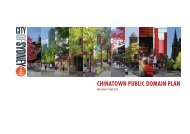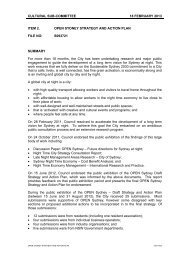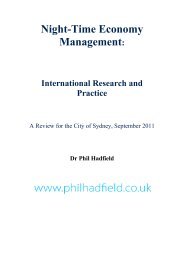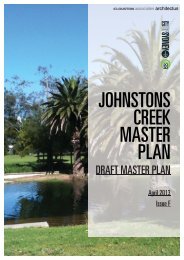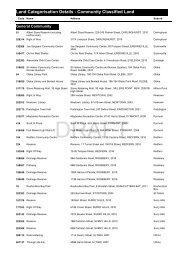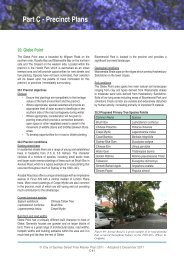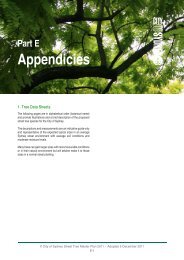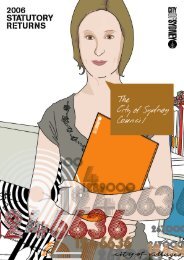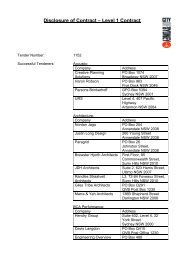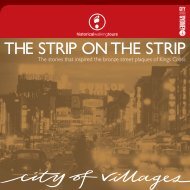Histories of Green Square - City of Sydney
Histories of Green Square - City of Sydney
Histories of Green Square - City of Sydney
Create successful ePaper yourself
Turn your PDF publications into a flip-book with our unique Google optimized e-Paper software.
Chapter 8 – <strong>Green</strong> <strong>Square</strong> and the Thin Blue Line<br />
Chapter 8 <strong>Green</strong> <strong>Square</strong> and the<br />
Thin Blue Line:<br />
Crime, Law & Order in<br />
the <strong>Green</strong> <strong>Square</strong> Area<br />
8.1 Introduction<br />
The histories <strong>of</strong> crime, law and order are important to recover.<br />
By looking at what was being policed in different periods<br />
we can learn what behaviour society—or some sections <strong>of</strong><br />
it—wanted controlled. These included, for example, practices<br />
associated with working class pastimes, such as gambling, the<br />
consumption <strong>of</strong> alcohol or bare knuckle prize fighting. We<br />
can see which crimes the community took seriously and<br />
which crimes they did not. At a general level, it may also be<br />
possible to gauge what respect, or otherwise, the community<br />
had for the police and for law and order.<br />
Of course the crimes are sometimes stories in themselves.<br />
Some were sensational, like the Mt Rennie rape case, which<br />
caused deep anxiety and enormous debate in <strong>Sydney</strong> in the<br />
1880s. Others were not sensational but give an idea <strong>of</strong> what<br />
sort <strong>of</strong> ‘ordinary’ crimes were taking place at the time. Crime,<br />
and the policing <strong>of</strong> it in a particular area, also reflects the<br />
kind <strong>of</strong> people who live in this area, and how the population<br />
changed over time.<br />
8.2 Crime, law and order at the local level<br />
The history <strong>of</strong> crime, law and order in the <strong>Green</strong> <strong>Square</strong> area<br />
is varied and interesting, but not always straightforward to<br />
research and reconstruct. While there are few problems in<br />
tracing key events or charting information such as the establishment<br />
or closure <strong>of</strong> police stations, crime is, by its very<br />
nature, complex. The question <strong>of</strong> what a crime actually is,<br />
is in itself a contentious question, as the definitions have<br />
changed.<br />
In the nineteenth century, for example, vagrancy was a<br />
crime, as was a husband deserting his wife, but today these<br />
practices are not considered criminal. Perceptions <strong>of</strong> crime<br />
are another factor to take into account. How seriously<br />
should a crime like illegal S.P. (Starting Price) betting be<br />
taken when the majority <strong>of</strong> the community did not consider<br />
it a crime? And what about crime statistics? Did they or do<br />
they reflect the everyday personal lives and experiences <strong>of</strong><br />
people who have lived in the <strong>Green</strong> <strong>Square</strong> area?<br />
There are also problems with the sources for the history <strong>of</strong><br />
crime. Up to 1946 there are gluts <strong>of</strong> information for some<br />
periods, which are difficult to represent unless readers are<br />
interested in a complete litany <strong>of</strong> names, dates and events.<br />
More recent times <strong>of</strong>fer the opposite problem. Official<br />
records on specific crimes are increasingly restricted as one<br />
draws closer to the present, to protect the lives and reputa-<br />
© Scott Vance<br />
Scott Vance<br />
tions <strong>of</strong> persons still living, or their relatives. Information<br />
might be gleaned from sources such as newspapers, but this<br />
is a highly selective record, as only stories considered by<br />
editors as newsworthy are printed.<br />
Another problem is placing crime in geographical boundaries.<br />
The term <strong>Green</strong> <strong>Square</strong> has only recently been coined<br />
and has not been an <strong>of</strong>ficial area in relation to gathering <strong>of</strong><br />
information such as crime statistics. So we cannot focus on<br />
<strong>Green</strong> <strong>Square</strong> specifically—but in a sense this is appropriate, as<br />
people’s experiences <strong>of</strong> crime would not be limited to theoretical<br />
geographical boundaries anyway. The sly grog shops and<br />
brothels centred in nearby Surry Hills in the 1920s and 1930s,<br />
for example, and recent riots and racial tensions centred in<br />
Redfern, have impacted beyond strictly narrowly defined<br />
boundaries into the <strong>Green</strong> <strong>Square</strong> area.<br />
Perhaps the best way to approach the history <strong>of</strong> crime, law and<br />
order is to take typical ‘slices’ at different periods in the <strong>Green</strong><br />
<strong>Square</strong> area, and compare these with more detailed accounts<br />
<strong>of</strong> the few sensational or extraordinary events. It also possible<br />
to look at this history in tandem with what was happening in<br />
the broader area <strong>of</strong> <strong>Sydney</strong>. To start with, this means looking<br />
at the establishment <strong>of</strong> an organised police force and how it<br />
came to the <strong>Green</strong> <strong>Square</strong> area.<br />
8.3 The beginnings <strong>of</strong> the police<br />
At the start <strong>of</strong> settlement in New South Wales, policing was<br />
a military responsibility, but gradually provisions were made<br />
for non-military watchmen and constables. 1 In 1833 an Act<br />
was passed for the appointment <strong>of</strong> two or more magistrates<br />
for the town and port <strong>of</strong> <strong>Sydney</strong>, ‘they being empowered to<br />
select men for a police force’. 2 Another Act was passed in 1838<br />
to expand the police force in principal country districts. It<br />
was, however, generally considered that the non-pr<strong>of</strong>essional<br />
policing system that emerged from these Acts was inefficient,<br />
and lacked co-ordination and structure.<br />
8.3.1 ‘Bluebottles’ and bare-knuckle prize fighting<br />
Nevertheless these police had a wide variety <strong>of</strong> duties to<br />
perform and problems to try and control. One activity they<br />
policed in <strong>Sydney</strong> occurred at the outskirts <strong>of</strong> the <strong>Green</strong><br />
<strong>Square</strong> area around this time—bare-knuckle prize fighting.<br />
Patrons and participants made their way to the Cooks River,<br />
especially around the 1840s, to fight, watch and bet on the<br />
result. Bare-knuckle prize fighting was a very popular sport<br />
at this time and, although it was not actually illegal, the<br />
63



